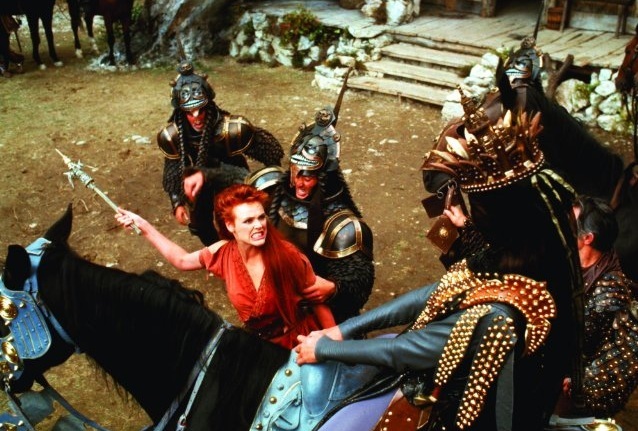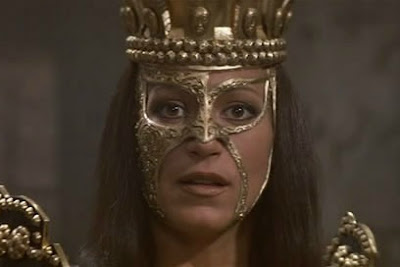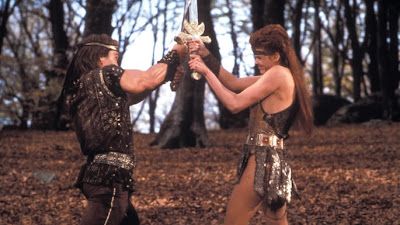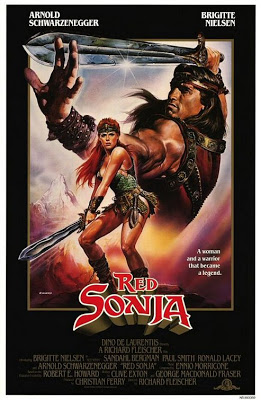Written by Amanda Rodriguez
True confession: 1985’s Red Sonja was my first lesbionic crush as a small child of four. I was in love with this strong Amazonian woman with her long red hair and big ol’ sword. It may be her fault that I wanted my dark brown hair to turn red and that red became my favorite color. I became completely obsessed with movies/TV shows starring women, especially badass babes, and I refused to watch anything that didn’t meet that criteria. As an adult, I’ve gone back to Red Sonja to see if it holds up to a feminist critique, and though it doesn’t always succeed, the film fares shockingly better than most contemporary action films starring women.
Firstly, Red Sonja passes the Bechdel test with flying colors. Though there aren’t many female characters in the film, Red Sonja speaks to most of them or they speak to each other, and they never talk about men. Not only that, but the great task of the film is to destroy the Talisman, an artifact that the “god of the high gods” used to create the earth that has since grown so powerful that it must now be destroyed or risk the destruction of the world itself. The Talisman can only be touched by women. The hierarchy in place dictates that priestesses protect the Talisman, but the High Lord (Kalidor played by Arnold Schwarzenegger) is the one who decides whether or not it is to be destroyed. This hierarchy certainly privileges men over women, but throughout the course of the film, men are repeatedly rendered obsolete (if not completely obliterated) when they encounter the Talisman. Men’s inability to touch the Talisman not only makes them impotent, but it makes women the major players who will determine the fate of the world.
 |
| Badass barbarian babes Red Sonja and Queen Gedren go head-to-head over the Talisman |
The characterization of Queen Gedren, the villainous lesbian played by Sandahl Bergman, is a bit more complicated. On the one hand, having a main character of a film be a lesbian is a pretty bold move, especially in a film that was made nearly 30 years ago. Gedren is shown to be a powerful, if tyrannical, figure who commands an army of men with ease.
In essence, Queen Gedren is the victim of a hate crime, and Red Sonja is the perpetrator. Gedren expresses her interest in Sonja, wanting them to “rule the world together.” Sonja rebuffs Gedren by slashing her across the face with a mace. The movie takes the side of Red Sonja here, claiming her “disgust was complete.” This somehow justifies the permanent disfigurement of another woman.
 |
| Queen Gedren wears a golden mask to conceal the scar left from Red Sonja’s attack |
Gedren retaliates by burning Red Sonja’s house to the ground, having her soldiers gang-rape Sonja, and murdering her family. Of course, it’s difficult to feel sympathy for a woman of dubious intentions who shows up with a troop of armed men who end up raping Sonja and wholesale slaughtering her family. Interestingly, the original comic character upon which Queen Gedren is based was a man. The filmmakers deliberately altered the character into not only a woman, but a lesbian. I examined the implications of this exact cinematic choice in the character of Admiral Helena Cain from Battlestar Galactica. In both cases, the rendering of a lesbian as power hungry, brutal, and morally bankrupt indicates a fear of women in power, rendering them paradoxically weak and “womanish” slaves to their emotions as well as overly masculine.
 |
| And as usual, the evil lesbian is punished with death |
In order to give Red Sonja the vengeance she so craves, a warrior goddess imbues her with mystical powers of strength and skill at weaponry. Though the idea of a female deity choosing a human woman as her champion has some “girl power” qualities, I’m disappointed that Sonja doesn’t earn her fighting prowess the way her male counterpart Conan does. Both characters are the creations of fantasy writer Robert E. Howard, but the cinematic version of Conan spends much of his youth enslaved, growing strong by pushing the Wheel of Pain around in circles before he is intensively trained for the gladiator arena with multiple disciplines of martial arts. The implication is that the only way a woman could be as physically tough and skilled as a man is through magic. However, Red Sonja has also taken a vow. “No man may have me unless he has beaten me in a fair fight,” she says. Arnold Schwarzenegger’s Kalidor, of course, feels compelled to challenge that vow. He cannot beat her. They are equally matched and fight until they both collapse in exhaustion. Hoodoo influences aside, the cinematic depiction of male and female leads being equals on the battlefield is rare.
 |
| Arnie muscle can’t fight the power of the Kentucky waterfall mullet |
Many viewers have complained about the shortage of Arnie scenes in this film, but though he got top billing and is way more prominently featured in the movie poster (above), Kalidor is truly a supporting character. In fact, Kalidor takes a back seat to Red Sonja throughout their journey to Burkubane, the Land of Perpetual Night. He appears periodically throughout their quest, helping as needed, then eventually joining the group before the final showdown. Proof of the supporting nature of his role is in the fact that Arnold Schwarzenegger is never topless throughout this movie. Maybe that seems like a silly observation, but think about how many movies Arnie starred in during the 80’s where he showed his man boobies at some point. The answer is: all or most. The heroine is actually the lead in Red Sonja. She alone can destroy the Talisman. She alone defeats her enemy in single combat and saves the world. How often do you see that happen in a movie?
All in all, Red Sonja was a formative film for me, a girl child of the 80’s. Its representation of the evils of lesbianism is inexcusable, but as a queer woman, I confess that I still love to watch the malevolent, beautiful Queen Gedren in action. It is, perhaps, sad that queer female characters in film and TV are such a rarity that I and so many others will take whatever we can get. Bottom line: The character of Red Sonja is strong, independent, and an expert in a traditionally male area of skill. She cannot be beaten by a man, she calls all the shots, and, in the end, she saves the world. It ain’t perfect, but I feel fortunate that the film was there to help shape my youthful feminist inklings.
If you’re feeling frisky, check out my drinking game, Rye & Red Sonja on my Booze & Baking site.
 |
Rye & Red Sonja |
———-

